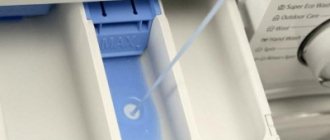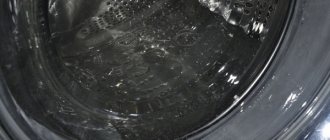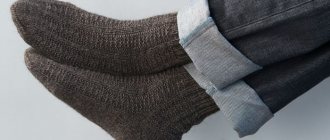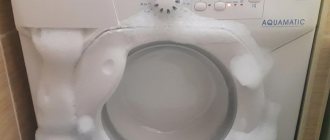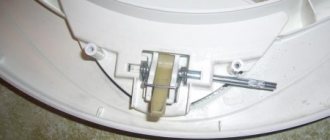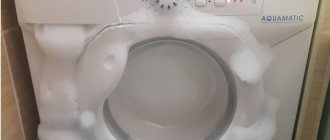Many of us are familiar with the problem of socks disappearing after washing in the washing machine . Many different reasons for this phenomenon and versions of the possible location of these wardrobe items have been put forward. One thing can be said with confidence: if the sock was placed in such a unit, it remained in it .
Socks lost in this way can be found if you know where to look for the loss most appropriately. Let's figure out where the socks disappear (“go”).
Consequences of clogging
Clogging household appliances with a foreign object does not bode well.
Very often, such blockages cause obstruction of the drain pipe and lead to the fact that the apartment may be flooded. In addition, individual parts, such as a drum, may be damaged if the sock prevents it from functioning normally. Even if you are not sure that you started to wash exactly 2 socks, it is better to play it safe and make sure that it did not get stuck inside. Caution will help you maintain the integrity and performance of your expensive equipment.
How to stop the machine
If you suspect that something has gone wrong, unplugging the cord is not the best solution. Such an action may cause a breakdown of the control module or the machine will remember the procedure being performed and return to it as soon as it is connected to the network again.
To emergency stop the washing machine, you need to press the “Start/Pause” button, then press it again and hold for about 5 seconds. After this, the process of stopping the machine will begin. If the pump fails to drain the water, then you need to do it yourself - through the “emergency” drain (it is a small hose located next to the filter) or through the filter itself. Draining the water is mandatory, because otherwise you will not be able to open the machine.
Where to look for a sock
Where do socks most often go in the washing machine?
- Soft, sealing cuff on the hatch door;
- Tank bottom;
- Pipes;
- Drain filter or snail;
- Drum.
You can only find a stuck sock using your hands. Therefore, probing the elements of the washing machine can take quite a long time.
Recommendations
Unpleasant situations with foreign objects in the washing machine can be prevented if you are a little more careful and follow the recommendations:
- firstly, you need to check the pockets of your clothes before washing and the reliability of how small details on the clothes are sewn;
- secondly, check the contents of the drum before washing and look into the powder cuvettes;
- thirdly, clothes with sewn details, zippers, buttons, underwires, etc. need to be washed in a special bag. And then nothing will get into the car tank and damage it.
Violation of such simple rules leads to unpleasant situations. In the best case, some unnecessary thing will be damaged, in the worst case, a foreign object will pierce the tank, and then expensive repairs cannot be avoided.
Where to look first
As already mentioned, it’s better to start your search with the simplest thing. During this procedure, you do not have to disconnect the automatic machine from the power supply: open the hatch door and look under the edge of the seal. An object could get stuck in the gap that is located there. If you notice a bulge or edge of the sock, carefully remove it so as not to damage the seal.
If the cavity under the seal is empty, you need to check the drain filter. It is located in the front of the automatic machine, under the false panel or small hatch. Place a cloth under the drain, onto which the remaining liquid from the machine will drain, and unscrew it. Look for a sock in the filter opening and in the drain hose - socks often get caught there under the influence of strong water pressure.
Search without disassembling the machine
As we recommended, it is more advisable to start searching for the loss from easily accessible places in the automatic machine. In this case, it is allowed not to disconnect the equipment from the power supply and utilities. First, open the hatch door wide and bend the edge of the seal. You should act carefully so as not to damage the cuff. Under the elastic band there is an impressive gap where the sock could get stuck. If the product is visible in the cavity under the cuff, it should be carefully removed from the housing.
If the space under the cuff is empty, you need to remove the drain filter. It is located on the front side of the car behind a special hatch or lower false panel of the front wall. Unscrew the filter element, not forgetting to place a rag under the resulting hole to collect water. Check the garbage filter and the exposed snail hole for the presence of a foreign object.
Checking the bottom of the tank
If the simplest search methods do not bring the expected result, then you will have to disconnect the washing machine from the power supply and house communications, and begin more complex work. Move household appliances away from the wall so that you can inspect them without obstruction.
Check under heating element
The bottom of the tank is where socks often disappear from the washing machine. The first sign that this has happened is the appearance of a creaking sound during operation.
To find a product, you will have to make a lot of effort. It will be necessary to dismantle one of the most important parts of the automatic machine - the heater. You need to be as careful as possible with the heating element, otherwise it may affect the further operation of the equipment.
Find out where the heating element is located on your equipment. Its location differs in different models: in some it is behind the back wall, and in others it is behind the front cover. Unscrew the housing wall bolts to gain access to the heater. In order to avoid problems in the future, be sure to photograph the location of the wires. Remove the element and inspect the resulting hole.
Shine a flashlight to get a good look at the bottom for any foreign objects. If you notice it, look for wire or something else that can be used to hook and pull out the sock (a thin hook is ideal).
Complex cases
Unfortunately, it is not always possible to get an object out of the car. If a woman's bra wire or other object is stuck at the top of the drum, you have to use slightly different methods. In this case, how to get the bone of the automatic machine? First of all, unscrew the bolt that holds the drum pulley. Then we disconnect the pulley and screw the bolt back. Using a hammer, knock the drum shaft out of the bearings. As soon as the drum moves off its axis, you need to carefully rotate it, trying to move the stuck object to the bottom of the tank. After moving the bone from the bra to the bottom, using tweezers, carefully remove the object through the hole of the heating element.
Often housewives, when washing small items of clothing, discover that after washing, not all socks or handkerchiefs were removed from the drum. Under the influence of strong water pressure, such objects often end up in the pump filter or drain hose. If you don't know how to remove socks from the washing machine, first check the drum for foreign objects. Sometimes small pieces of clothing stick to the walls of the drum and can only be found manually.
If, as a result of such manipulations, a sock or scarf was not found, it is necessary to open the hatch of the pump filter. How to remove the filter from the washing machine? At the bottom of the front panel of the unit there is a small door behind which the filter is hidden. Having opened the hatch, you need to unscrew the filter, which may contain the lost item. Carefully remove all the parts that have settled in the filter, wash this element and install it in its original place.
The video provides step-by-step instructions that will help you remove any stuck item in your washing machine.
A few recommendations
To get any item settled at the bottom of the washing machine tank, it is necessary to carry out quite painstaking work to dismantle the heating element
Since this structural element is one of the main ones, it is necessary to remove it very carefully. Upon completion of the manipulations, it is recommended to treat the rubber gasket of the heating element with any detergent that will ensure trouble-free installation of the part in place
By the way, if during the dismantling process severe contamination of the heating element was noted, it is necessary to clean the part from scale and other deposits. The same recommendation applies to the bearing system.
If you had to dismantle the drum, pay attention to the condition of the bearings. If these parts are covered with limescale, it means that the oil seal has become unusable and requires replacement.
Thus, if during operation the washing machine begins to make squeaking sounds, most likely a small object is stuck in the drum. To remove it, first stop the operation of the unit and disconnect it from the power supply. Then we determine the location of the objects. If an item is stuck in the lower zone of the tank, you can get it out using the hole for the heater. In other cases, you will have to disassemble the machine by unscrewing the back wall. If you cannot get the item on your own, it is recommended to seek help from professionals.
Sock on the outer wall of the drum
If in order to find and remove the sock it is necessary to dismantle the drum in addition to the heater, then it is better to seek help from a specialist. This is a rather complicated procedure, and it is difficult to understand it without special skills. In the worst case scenario, it may even be necessary to dismantle the drum elements or cut them.
If you still decide, unscrew the bolt that holds the drum pulley. Remove the pulley and screw the bolt back in. Knock the drum shaft out of the bearings. When the drum has moved off its axis, it should be rotated, trying to ensure that the stuck product is at the bottom. Remove the sock using long tweezers or stiff wire.
After the procedure, it is necessary to check the condition of the bearings. If they are covered with a thick coating, the oil seal should be replaced, as it has become unusable.
Determining the location
Since during the operation of the unit, things loaded into the drum are constantly moving, buttons, coins and other elements can settle in a variety of places. Therefore, if you suspect the presence of a foreign object in the machine, it is recommended to check the following areas:
- Drum bottom.
- Bottom of the tank.
- The distance between the drum and the walls of the tank.
- Drum shaft.
The exact location can only be determined manually, by probing and inspecting all cavities.
About the disappearance with humor
Some people try to joke about socks missing after washing. As a result of such jokes, a lot of myths appear. Here are some of them:
- The washing machine has a shredder installed. When a small item gets into it through a hole in the cuff, processing occurs. And the sock turns into small pieces and is washed down the drain;
- one of the socks is taken by the brownie as revenge for his bad attitude;
- socks disappear as a result of a secret conspiracy of manufacturers who came up with a special impregnating composition for the fabric; upon contact with water, one of the socks simply dissolves;
- socks move to a parallel reality, the door to which is in your apartment.
All this, of course, is nonsense, contrary to the laws of physics. Socks do not dissolve or disappear. They are material and cannot disappear without a trace from the confined space of the machine, which means there is a very reasonable explanation for their disappearance.
Where to look for a lost sock after washing?
If the sock was placed in the drum of the washing machine, then it will not disappear anywhere outside the machine. Where can such a part of the wardrobe go?
- Very often the sock gets caught under the rubber cuff. To get it out, you just need to move the elastic band back.
- Small socks can slip through the gap between the tank and the drum and end up in the tank, remaining there for a long time. You can try to pull the sock out of the tank through the hole for the heating element, which will require you to disassemble the machine a little.
- If a sock gets into the drum, then from there it can get out along with the waste water and get stuck in the drain pipe or drain filter. It is not difficult to remove the sock from the filter, but to remove it from the nozzle, you will have to disassemble the machine and remove the pump.
- If you wash your socks along with your bed linen, then very often the socks get inside the duvet cover or pillowcase.
The conclusion can be drawn as follows: if you put a pair of socks in the drum of a washing machine, then you only need to look for the missing sock in the machine.
It’s another matter if there were initially an odd number of socks. Maybe the missing sock is in the remaining pile of dirty laundry, or maybe it’s lying in the room under the sofa or bed, maybe it was stolen by a cat or dog.
How to avoid losing socks again
To avoid having to take a mountain of single socks out of the machine after washing, follow a few simple tips:
- wash small items, including hosiery, in a special laundry bag;
- Use small clothespins for washing, fasten pairs of socks with them before washing and then they will definitely not lose each other. By the way, such clothespins can be used not only for washing, but also for storage;
- For the lazy, a simple solution is suitable - buy several pairs of identical socks at once . And even if one of the socks disappears, it will easily match a sock from another pair. You can stock up on several pairs of socks of different colors, for example, 7 pairs of gray and 7 pairs of black.
With this method, you don’t have to think about storing socks in pairs, and you can throw out broken socks one at a time, rather than two at once. Very economical too.
- hand washing will help to radically solve the problem of sock disappearing from the washing machine, yes, no matter how sad it may sound, but where to go. They wore the socks and immediately washed them by hand.
Wash by hand
If socks are heavily soiled, they must be washed. To do this, soap the product with laundry soap or detergent. If there are greasy stains, apply dish soap and then scrub vigorously with your hands.
After washing, change the water and rinse thoroughly. If necessary, repeat the procedure again.
How to whiten socks
Socks made from natural fabric can be bleached by boiling.
- Take a container of water.
- Add laundry detergent and the juice of a few lemon slices.
- Boil for 15 minutes over low heat.
- If there are streaks or dark spots on your socks, wash them by hand.
- Rinse clothes thoroughly.
So that there are no pellets
Wool socks are washed on both sides in warm water, using shampoos and products suitable for this type of material. If the yarn from which the product is made is softly twisted or of poor quality, pills may form on it. You need to wear such clothes carefully, avoiding unnecessary friction and mechanical impact.
Katyshkina wearing woolen socks is a very common occurrence
Terry and angora socks also do not like hot water, strong squeezing and friction. Otherwise, they will quickly lose their appearance.
WHERE DO SOCKS GO FROM THE WASHING MACHINE AND HOW TO AVOID IT!
Very often the sock gets caught under the rubber cuff. To get it out, you just need to move the elastic band back.
Small socks can slip through the gap between the tank and the drum and end up in the tank, remaining there for a long time. You can try to pull the sock out of the tank through the hole for the heating element, which will require you to disassemble the machine a little.
If a sock gets into the drum, then from there it can get out along with the waste water and get stuck in the drain pipe or drain filter. It is not difficult to remove the sock from the filter, but to remove it from the nozzle, you will have to disassemble the machine and remove the pump.
If you wash your socks along with your bed linen, then very often the socks get inside the duvet cover or pillowcase.
It’s another matter if there were initially an odd number of socks. Maybe the missing sock is in the remaining pile of dirty laundry, or maybe it’s lying in the room under the sofa or bed, maybe it was stolen by a cat or dog.
When to call a specialist?
Three situations are possible:
- A thin object, such as a bra wire, got stuck in one of the holes in the drum. To remove it, pinch the accessible end with pliers and gently pull, being careful not to break it. Of course, such a task can be completed without a specialist.
- The loss is not visible, but you are sure it is in the typewriter. Small things like a chain, screw, or coin may end up in the drain filter. It’s not difficult to get them yourself - you don’t need a master either.
- If you hear a clanging noise as the machine is running, as if metal is rubbing against metal, a foreign object may have gotten underneath the drum. At this point you need to call a specialist. A metallic sound may also indicate wear or malfunction of a part. It is difficult to diagnose a breakdown without the help of a specialist.
Where do socks go in the washing machine?
Many of us are familiar with the problem of socks disappearing after washing in the washing machine .
Many different reasons for this phenomenon and versions of the possible location of these wardrobe items have been put forward. One thing can be said with confidence: if the sock was placed in such a unit, it remained in it .
Socks lost in this way can be found if you know where to look for the loss most appropriately. Let's figure out where the socks disappear (“go”).
Where to look for lost socks after washing in the machine?
There are several main reasons why socks disappear in the washing machine during the washing process.
These include the following:
Socks can get caught under the rubber cuff , located next to the porthole and provided by the manufacturers of such units to ensure tightness. Sometimes the rubber seals are not elastic enough. This can also happen if too many different wardrobe items have been loaded into the washing device. In this case, when the drum rotates, the sealing collar is greatly stretched and a small object, such as a sock, can easily get under it.
Thin items or small children's socks can
get caught in the gap between the drum and the tub during the washing process and get stuck there for a long time . A white sock stuck in the depths of such a unit will not cause much harm. But if a black or colored item gets stuck and is not removed in time, it can shed and significantly damage the clothes placed in the machine during subsequent washes. You can get the product out of this place through the hole for the heating element, but for this purpose you will have to partially disassemble the washing machine. In addition, when washing the product, the product may end up directly in the drum of the washing machine and from there under the influence of strong water pressure (above 1000 spin speeds) get into either the drain filter or the drain pipe. It’s not difficult to get something of this kind out of the drain filter; just unscrew it and pull out the lost item. If the sock is in the drain pipe, it will be more difficult to get it out, since you will have to completely disassemble the washing machine . In some cases, you may even need the help of a professional. One of the most common reasons for the disappearance of such items in the washing machine may be bed linen (duvet covers and pillowcases), into which hosiery often gets clogged during washing.
Important! Actions aimed at removing a sock stuck in it from a washing machine must be carried out when this unit is completely disconnected from the power supply.
Extraction
You can remove a bra wire at home by disassembling an automatic machine. Before performing any of the above methods, you need to drain the water and disconnect the washing machine from the power source.
Through the drain
The lost piece of underwear may be in the drainage system. It can be obtained in 3 ways:
- Through a filter. You need to remove the narrow panel at the bottom of the front wall of the machine. Usually on the left side there is a hatch behind which there is a filter. You need to tilt the machine back, place a rag under the bottom and press on the lid that closes the mechanism. Next, the filter is removed. The bone can be located in it, or in the pump located immediately behind it (visible in the resulting hole). After removing it, the part is screwed back in and covered with a panel.
- Through the pipe. The machine must be placed on its side and the bottom cover, if present, must be removed. There is a pipe between the tank and the pump; you need to loosen the fastening clamp on it and remove the part. If the bone does not fall out on its own, you should shine a flashlight into the hole and look for it between the heating element and the tank. After finding the lost part, you need to put the pipe back, fasten the clamp and bottom panel, and then place the washing machine vertically.
- Through the pump. If the machine does not drain water well or makes a loud noise during the process, it can be assumed that a part has gotten into the pump, although this is a rare occurrence. Before you remove the bra wire from the washing machine drum through the pump, you need to find out where it is located in this model.
In most machines, the pump is located behind the drain system filter. You can detect it by following the steps provided in method 1. In Electrolux and Zanussi brand machines, the pump is located closer to the back panel, so you need to unscrew it to gain access to the mechanism.
In German models, to find the pump, you need to remove the top and front covers, and also remove a number of other elements. This is difficult to do without experience, so it is better to turn to specialists.
After determining the location of the mechanism, you need to place containers to collect water and place rags under the washer. Next, disconnect the power connector, unscrew the fastening screws, and detach the drain hose and pipe that come out of the pump. After this, unscrew the volute from the housing, remove the engine, inspect the casing and parts for the presence of a bone.
If there is no damage to the pump, then it can be assembled and installed in place; if there is, buy and secure a new mechanism.
Through a tubular electric heater
Most often, a stuck element can be found directly under the electric heater, or between its tubes. The extraction method is suitable for machines with horizontal loading, in which the heating element is located at the rear. To use it, you must complete the following steps:
- Drain the water and turn off the electricity supply.
- Turn the washer back towards you.
- Remove the back panel by unscrewing the screws.
- Locate the large wheel (drum pulley).
- Directly under this mechanism, find contacts with wires (the visible part of the tubular electric heater).
- Remove the terminals from the 2 wires.
- Loosen the nut on the stud, which secures wire 3, without removing it completely (only until it reaches the back line of the stud).
- Press the pin, pressing it inside the electric heater to the level of the nut.
- Using your hands, rock the heating element (the mechanism itself, do not pull the wires) little by little and pull it out.
- Find a bone between the heater tubes. If it is not there, then look through the hole formed after removal into the tank, it should be there.
- Use a hook or knitting needle to pick up and pull out the find.
- Inspect the heating element for damage and dents. Insert the mechanism back if they are missing, or replace it with a new one if deformations are detected.
- Tighten the nut and connect the terminals.
- Without screwing the back cover, run a test wash. If no water leaks are detected and the washing machine is working normally, then screw the panel into place.
Removing a foreign object without disassembling the device
If a bone from a bra gets into the drum, you can get it out without disassembling the washing machine. There are several ways to do this:
- If you manage to feel the tip of the bone on the surface of the drum, you should, armed with tweezers or pliers, pull it and remove it.
- If a foreign object gets inside the washing machine, you need to bend the rubber seal of the front panel hatch. After this, you should push the drum a little to the side, feel for the metal part of the bra with the hook, hook it and pull it out.
- It is necessary to shine a light through the perforation; if the bone is visible, then you need to make a hook with bends at both ends from wire or a large paper clip. One turn should be secured to a finger so that the structure does not fall through the grate; with the second, try to catch an object that has fallen into the tank.
After fixing the bone with a hook, you need to try to lift it vertically and get into one of the holes in the perforation. It is better to ask an assistant to rotate the drum a little to achieve a greater likelihood of hitting the hole. It is permissible to use thread or thin rope instead of wire. You need to make a tightening loop at one end, hook the bone on it, and pull out the lace.
Some models of top-loading machines have a special hatch for removing seeds and similar things. It is necessary to close the washer flap, turn the drum halfway, then open it again and return the mechanism to its place. Next, through the hatch, which is located opposite the doors, get the lost item.
Proven ways to avoid losing socks?
In order not to wonder every time where to look for such a loss, it is advisable to adopt one of the methods listed below.
Recommendations:
Advice! A guaranteed way to avoid socks disappearing in the wash is to wash such items by hand.
When washing things in a washing machine, the unit periodically becomes clogged with various small objects. In addition to socks, it can also be coins, pins, buttons, handkerchiefs and other things of this kind . This can be evidenced by the characteristic creaking sounds made by the washing machine during operation.
LG Twin Wash
This washing machine from Korea is the dream of a modern housewife.
Despite the fact that it has two washing tanks at once, the machine is small in size. This technique is also called two-story. The main drum of the washing machine is no different from other washing machines. You can wash any linen in it, from different types of fabrics, because there are more functions for this.
This washer is, as it were, raised on a “pedestal”, and all because in this very “pedestal” there is a second drum. It is much smaller in volume than the main drum and is designed for washing small clothes and linen. Without hesitation, you can wash all your socks, underwear, or freshen up a couple of shirts in it. The machine not only washes things, but also rinses and spins them.
This washing machine from LG has all the latest features. Among them you will find stain removal, delicate washing, a steam function during washing, and starting washing from a smartphone via Wi-Fi.
Where do the socks go?
Believe me, not a single thing disappears without a trace! The second sock is always there somewhere, lying and waiting. It's just important to know where to look. Yes, washing machines and their design features are to blame. To allow free rotation of the drum, the manufacturer leaves a gap between it and the casing. If you load a lot of laundry, then under the influence of centrifugal force small things are squeezed out of the total mass. In this way, small socks and handkerchiefs can float freely through the sewer. Although they can also clog the drain and cause a flood... In addition, due to the design, clothes can get caught in the cracks of the seal.
If shedding material gets clogged under the rubber seal, it can ruin other things during the next wash, which is why it is so important to inspect the drum after each wash!
How to avoid problems?
To prevent breakdowns and not resort to expensive repairs, it will be useful to listen to constructive recommendations:
- Make it a rule: before washing, you should turn out all the pockets of your clothes.
- Sew on poorly holding buttons and small accessories in a timely manner.
- Look inside the machine and into the powder drawer before loading clothes.
- Buy laundry bags. They come in a variety of shapes and sizes, and can be used to wash everything from socks to down jackets. There are even special containers for washing bras. You can also wash sneakers and textile shoes in bags. Thanks to such useful, unpretentious devices, you will maintain the attractiveness of things and protect your washing machine from troubles.
Video “How to remove a foreign object”:
By following basic rules, you can avoid many problems and losses. It’s good if inexpensive small things just got into the tank or got stuck - with a little fiddling, you can get it out. But if a sharp foreign body disrupts the integrity of the tank, serious and expensive repairs will be required.
How to find something missing
I have collected a list of hiding places, it will help in the difficult search for fugitives.
- Rubber cuff for loading hatch . This is a useful thing that ensures tightness, but if it is not elastic enough, it stretches and hides a small object. It will be problematic to get it; you will have to disassemble part of the unit from the heating element side. Stretching often occurs when the machine is overloaded, so we remember the maximum load, and the machine will thank us with a long service life.
- The fugitive can be found in the plum. If a sock gets stuck in the drain filter, the release process is simple: you need to unscrew the filter and remove it. If we are talking about the drain pipe, then you will have to look for a professional to completely disassemble the washing machine.
- But still, most often (fortunately!) the loss is discovered somewhere in the corner of a duvet cover or pillowcase. Large things often hide their smaller brothers in secluded corners.
Don't forget to unplug your washing machine while searching!
When to call a specialist?
Three situations are possible:
- A thin object, such as a bra wire, got stuck in one of the holes in the drum. To remove it, pinch the accessible end with pliers and gently pull, being careful not to break it. Of course, such a task can be completed without a specialist.
- The loss is not visible, but you are sure it is in the typewriter. Small things like a chain, screw, or coin may end up in the drain filter. It’s not difficult to get them yourself - you don’t need a master either.
- If you hear a clanging noise as the machine is running, as if metal is rubbing against metal, a foreign object may have gotten underneath the drum. At this point you need to call a specialist. A metallic sound may also indicate wear or malfunction of a part. It is difficult to diagnose a breakdown without the help of a specialist.
